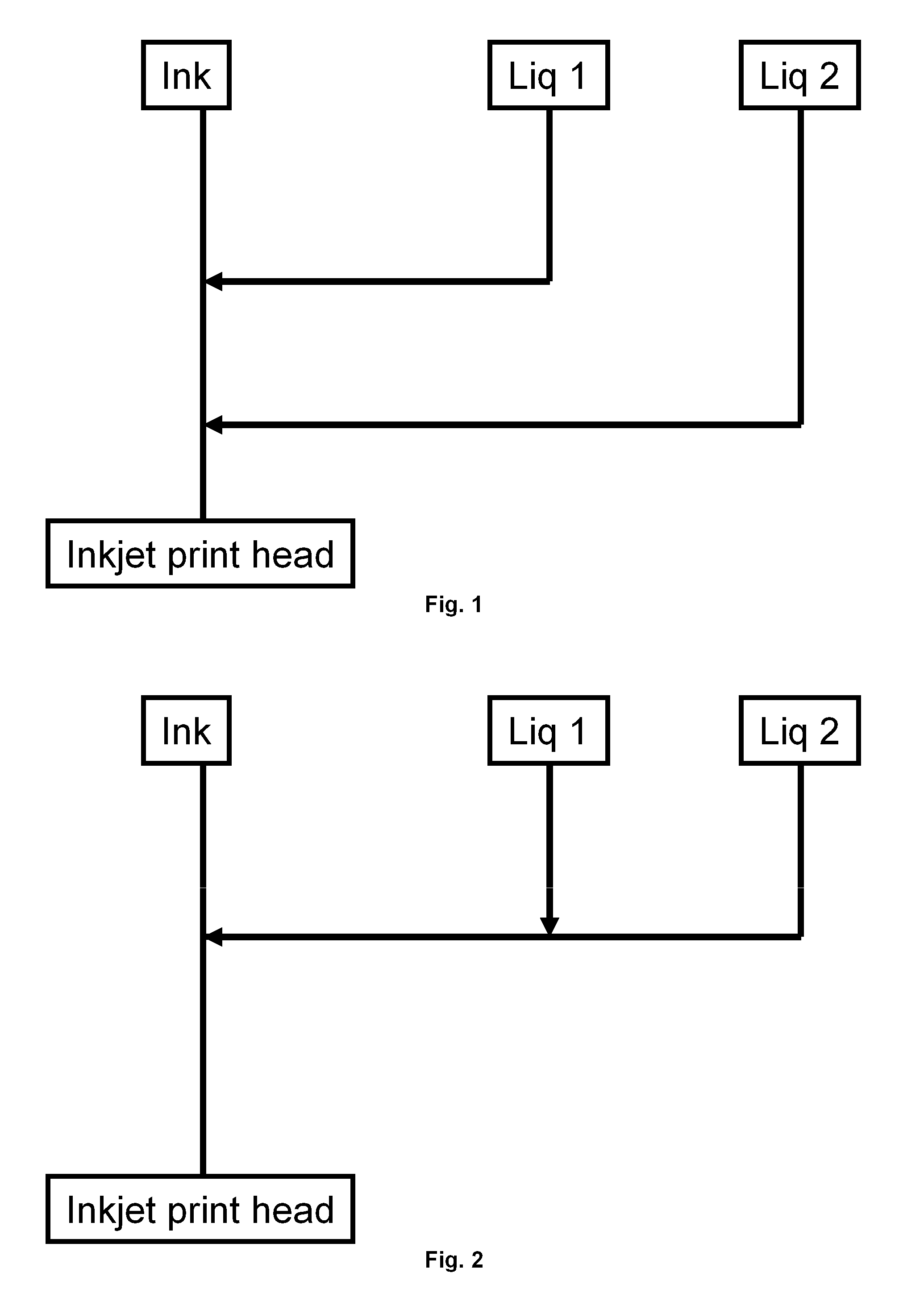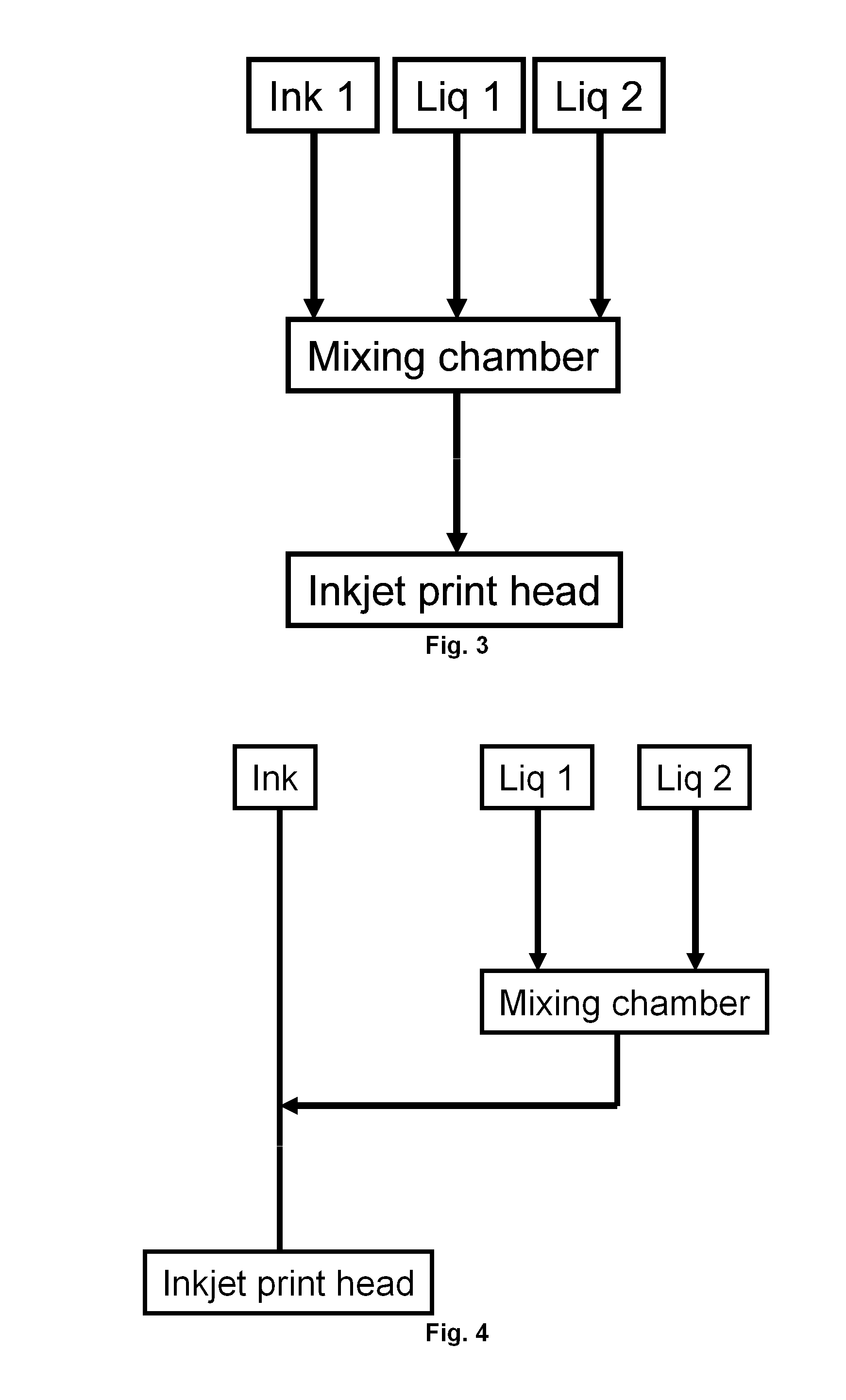White inkjet ink improved for dispersion stability
a technology of dispersion stability and inkjet printing, which is applied in the direction of inks, printing, instruments, etc., can solve the problems of poor controlled spread of ink on the ink-receiver, and inability to achieve good dispersion stability, etc., to achieve the effect of improving image quality and mediocre image quality
- Summary
- Abstract
- Description
- Claims
- Application Information
AI Technical Summary
Benefits of technology
Problems solved by technology
Method used
Image
Examples
example 1
[0387]This example illustrates how sedimentation problems in inkjet printing can be largely reduced by using higher concentrations of TiO2, leading to higher viscosity and reducing the viscosity before jetting by dilution with a colorless liquid.
Preparation of White Pigment Dispersion
[0388]Concentrated white pigment dispersions W1 and W2 were prepared according to Table 3.
TABLE 3wt % of:W1W2TR5250.050.0SOLSPERSE ™ 3600010.010.0GENORAD ™ 16 1.0 1.0VEEA39.0—IBOA—39.0
[0389]The concentrated pigment dispersion W1 was made by mixing 500.0 g of the white pigment TR52, 20.0 g of a 50% solution of the inhibitor GENORAD™ 16 in VEEA and 333.3 g of a 30% solution of the polymeric dispersant SOLSPERSE™ 36000 in VEEA for 30 minutes using a DISPERLUX™ Laboratory Dissolver YELLOW075 from DISPERLUX S.A.R.L., Luxembourg. This mixture was subsequently milled in an Eiger Lab Bead mill (from EIGER TORRANCE Ltd.) using yttrium-stabilized zirconium oxide-beads of 1-1.6 mm diameter (“high wear resistant zi...
example 2
[0399]This example illustrates the basic principle of how the same dot size can be obtained for a white inkjet ink on different substrates using two curable liquids with a different surface tension. In order to allow accurate measurement of dot sizes on white substrates, the white pigment in this example was replaced by a magenta pigment.
Preparation of Inkjet Ink
[0400]A concentrated pigment dispersion P1 was prepared according to Table 8.
TABLE 8wt % of:P1RT-355-D20.0SOLSPERSE ™ 3500020.0GENORAD ™ 161.0DPGDA59.0
[0401]The concentrated pigment dispersion P1 was made by mixing 360.0 g of the pigment RT-355-D, 36.0 g of a 50% solution of the inhibitor GENORAD™ 16 in DPGDA and 1028.6 g of a 35% solution of the polymeric dispersant SOLSPERSE™ 35000 in DPGDA for 30 minutes using a DISPERLUX™ Laboratory Dissolver YELLOW075 from DISPERLUX S.A.R.L., Luxembourg. The milling mixture was then milled at a rotation speed of 13 m / s and a flow rate of 0.6 L / min. under cooling by a NETZSCH M LABSTAR1 ...
PUM
| Property | Measurement | Unit |
|---|---|---|
| viscosity | aaaaa | aaaaa |
| refractive index | aaaaa | aaaaa |
| surface tension | aaaaa | aaaaa |
Abstract
Description
Claims
Application Information
 Login to View More
Login to View More - R&D
- Intellectual Property
- Life Sciences
- Materials
- Tech Scout
- Unparalleled Data Quality
- Higher Quality Content
- 60% Fewer Hallucinations
Browse by: Latest US Patents, China's latest patents, Technical Efficacy Thesaurus, Application Domain, Technology Topic, Popular Technical Reports.
© 2025 PatSnap. All rights reserved.Legal|Privacy policy|Modern Slavery Act Transparency Statement|Sitemap|About US| Contact US: help@patsnap.com



